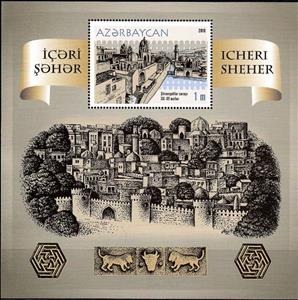Souvenir Sheet: Shirvanshahlar Palace Complex (12th-16th century) (Azerbaijan 2010)
Shirvanshahlar Palace Complex (12th-16th century) (Azerbaijan 2010)
26 July (Azerbaijan ) within release Baku - Old City goes into circulation Souvenir Sheet Shirvanshahlar Palace Complex (12th-16th century) face value 1 Azerbaijani manat
| Souvenir Sheet Shirvanshahlar Palace Complex (12th-16th century) in catalogues | |
|---|---|
| Michel: | Mi: AZ BL95A |
| Stanley Gibbons: | Sg: AZ MS774 |
Souvenir Sheet is square format.
Also in the issue Baku - Old City:
- Stamp - Architecture (Classical) face value 1;
- Stamp - Architecture (Classical) face value 10;
- Stamp - Architecture (Classical) face value 20;
- Stamp - Architecture (Classical) face value 30;
- Stamp - Architecture (Classical) face value 40;
- Stamp - Architecture (Classical) face value 50;
- Stamp - Architecture (Classical) face value 60;
- Souvenir Sheet - Baku - Old City face value 210;
- Stamp - Architecture (Classical) face value 10;
- Stamp - Architecture (Classical) face value 20;
- Stamp - Architecture (Classical) face value 30;
- Stamp - Architecture (Classical) face value 40;
- Stamp - Architecture (Classical) face value 50;
- Stamp - Architecture (Classical) face value 60;
- Souvenir Sheet - Baku - Old City face value 210;
- Souvenir Sheet - Shirvanshahlar Palace Complex (12th-16th century) face value 1;
Souvenir Sheet Shirvanshahlar Palace Complex (12th-16th century) it reflects the thematic directions:
Architecture (Latin architectura, from the Greek ἀρχιτέκτων arkhitekton "architect", from ἀρχι- "chief" and τέκτων "builder") is both the process and the product of planning, designing, and constructing buildings and other physical structures. Architectural works, in the material form of buildings, are often perceived as cultural symbols and as works of art. Historical civilizations are often identified with their surviving architectural achievements.
A building or edifice is a structure with a roof and walls standing more or less permanently in one place, such as a house or factory. Buildings come in a variety of sizes, shapes and functions, and have been adapted throughout history for a wide number of factors, from building materials available, to weather conditions, to land prices, ground conditions, specific uses and aesthetic reasons. Buildings serve several needs of society – primarily as shelter from weather, security, living space, privacy, to store belongings, and to comfortably live and work. A building as a shelter represents a physical division of the human habitat (a place of comfort and safety) and the outside (a place that at times may be harsh and harmful).
A palace is a large residence, often serving as a royal residence or the home for a head of state or another high-ranking dignitary, such as a bishop or archbishop. The word is derived from the Latin name palātium, for Palatine Hill in Rome which housed the Imperial residences



